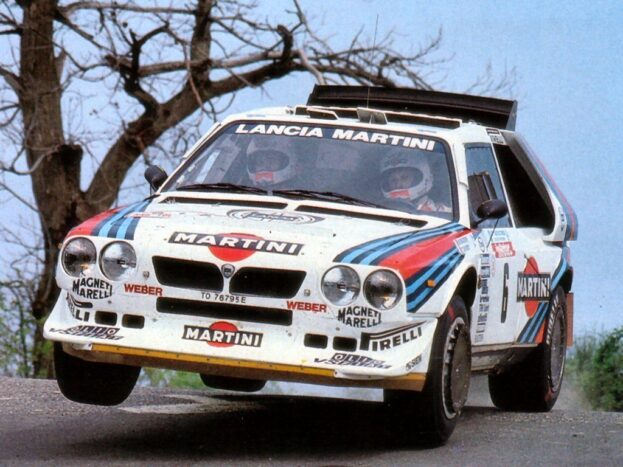|
#1
|
|||
|
|||
 Up until the mid-1990s, Italian manufacturer Lancia and rallying went hand in hand. By the time FISA unveiled Group B, Lancia, unlike Audi already had a long and lauded history in rallying. Their sexy, triangular fighter, the Stratos, had already been canonized in rally mythos. Like the Mini Cooper in the ‘60s, the Stratos eclipsed its material form and became a rallying symbol in the ‘70s. The Stratos lost factory backing in 1976 when Lancia’s parents at Fiat decided to back their own Abarth 131 instead. The car still tore its way to victory throughout the late ‘70s in the hands of privateers, but by 1980 the car was outclassed and out of style. Fiat gave Lancia the nod for another works rally car and a new project was under way by 1981 The 037 followed the Stratos in layout as a mid-engined, rear-wheel-drive coupe and was loosely based on the Lancia Monte Carlo (Scorpion in the U.S.) road car. It was designed by Fiat’s psychopathic in-house tuning firm Abarth, famous for their willingness to compromise anything but performance. The 037 chassis was the Monte Carlo’s center section sandwiched between tubular steel subframes and draped in lightweight Kevlar bodywork penned by Pininfarina. Suspension was fully independent fore and aft with the rear receiving a dual damper setup to keep the business end from bottoming out on rougher stages. Motivation was provided by a two-liter, twin-cam four topped with a roots type supercharger. The car produced around 265hp and weighed in at 2165 lbs. The 037 debuted in the 1982 World Rally season and was less than successful. While the car proved it could tear off quick stage times it also proved that further development was necessary: retirement was the norm for the 037 in ’82 Lancia charged into 1983 with the upgraded, much more reliable 037 EVO I. Changes came in the form of a new fuel injection system, a new supercharger providing more boost (bringing horsepower to about 315), an adjustable front chin spoiler, and revised steering and suspension components. The 1983 World Rally season was largely a schoolyard battle between the 037 EVO I and Audi’s Quattro rally car. Lancia came out on top with the 037 taking podium spots in seven of the 12 WRC rallies that year, winning five of them outright, and capturing the manufacturer’s title The 037 EVO I proved rear-wheel-drive still had a place in the WRC in ‘83, and Lancia returned in ’84 with the 037 EVO II, hoping to enforce that notion. The EVO II received a modest increase in engine displacement, a higher compression ratio, more boost, and a trick water injection system to keep this volatile mechanical combo from spraying a stew of hot oil and crunchy metallic bits all over each stage. Power came in at around 350 angry horsies. That year Audi captured both the manufacturer’s and driver’s titles. The EVO II performed admirably, drifting in just behind Audi for the manufacturer’s title with Peugeot and their 205 T16 nipping at its mud flaps For those of you taking notes, this is important: 1985 was a pivotal year for WRC, from this point forward almost every successful works WRC car has been all-wheel-drive. We shall pivot our focus here, too, in accordance with the muddy scriptures. That year Lancia and the 037 received little more than honorary participation awards, just like those trophies your dad angrily trashed when you were a little kid. It’s also important to note that a wreck in an 037 that year that killed driver Attilio Bettega and contributed to the FIA’s decision to ban Group B for 1987 The gravel flinging lunacy of Group B piqued in 1986 and Lancia’s Delta S4 was the king of the asylum, a savage mutant of a car with teeth like chainsaws and an insatiable appetite. The car was developed in 1985 and resembled Lancia’s road-going Delta hatch in name only: it was a mid-engined tubular spaceframe chassis covered in aggressively-winged, hatchback shaped carbon fiber panels. Power came from a heavily modified 037 EVO II mill: displacement was knocked down to 1.8 liters and compression was dropped so that Lancia could fit a turbo and a supercharger. That’s one way to kill turbo lag. The car made 500+ horsepower, weighed in at 1,962 lbs and was capable of blasting to 62 mph (100 km/h) in 2.3 seconds on gravel. Hot damn Lancia let the Delta S4 loose in 1985 at the U.K.’s Lombard RAC rally, the last WRC event of the year. It took both first and second place. Despite the laughably over the top numbers attached to the Delta S4, the 1986 WRC season wasn’t a game of Sunday afternoon T-ball for Lancia, the Peugeot 205 T16 proved a worthy adversary. Delta S4s took podium spots on seven of the 13 WRC rallies that year and won four outright. In the end, Lancia took second place behind Peugeot in both the manufacturer’s and driver’s championships Unfortunately, Lancia experienced another tragedy in 1986 when their star driver, Henri Toivonen, and his co-pilot, Sergio Cresto died in a fiery wreck on the eighteenth stage of the Tour de Course Rally. It was this wreck that sealed the fate of Group B and the FIA banned the class for 1987 immediately afterwards. Earlier that year Toivonen had famously lapped Portuguese GP circuit Estoril in a Delta S4 with such speed that he would’ve qualified for a sixth place starting position in the 1986 Portuguese Grand Prix |
 |
| أدوات الموضوع | |
|
|